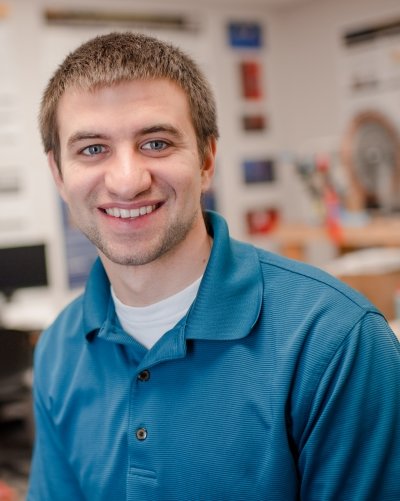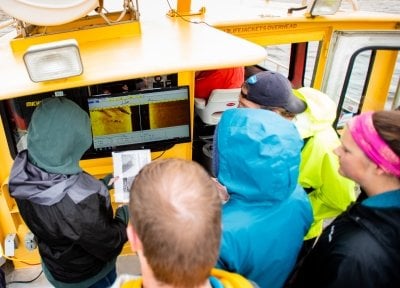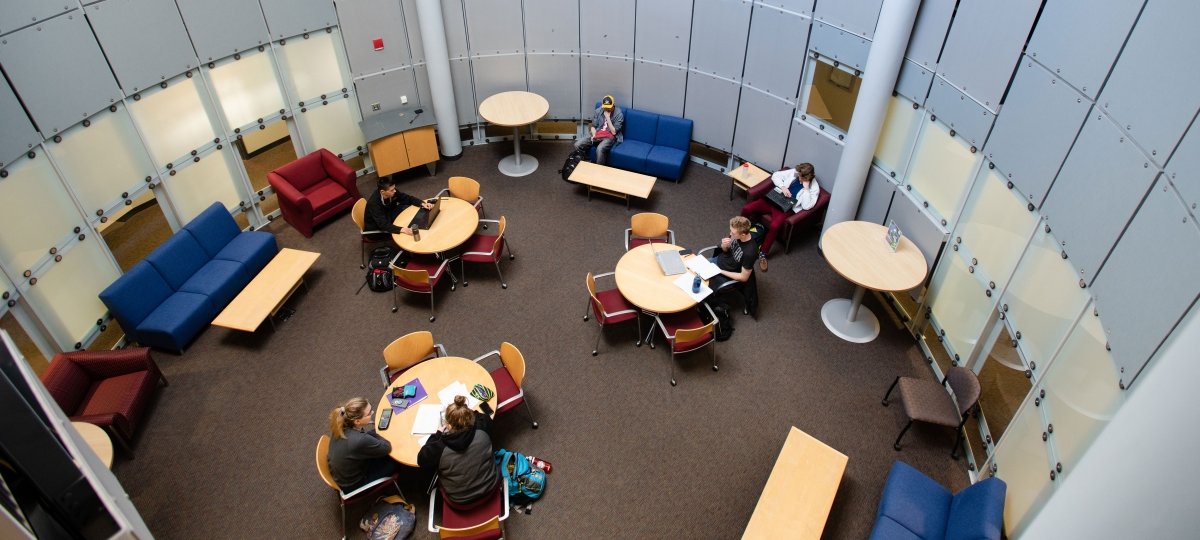Campus life has never been more exciting. New technologies, centers, graduate programs, and student scholars. Dive into the excitement at 1400 Townsend Drive.
Anatomy of a Smart Jet Ski
Researchers at Michigan Tech's Marine Autonomy Research Site (part of the Great Lakes Research Center) are making a jet ski into an autonomous surface vehicle (ASV).
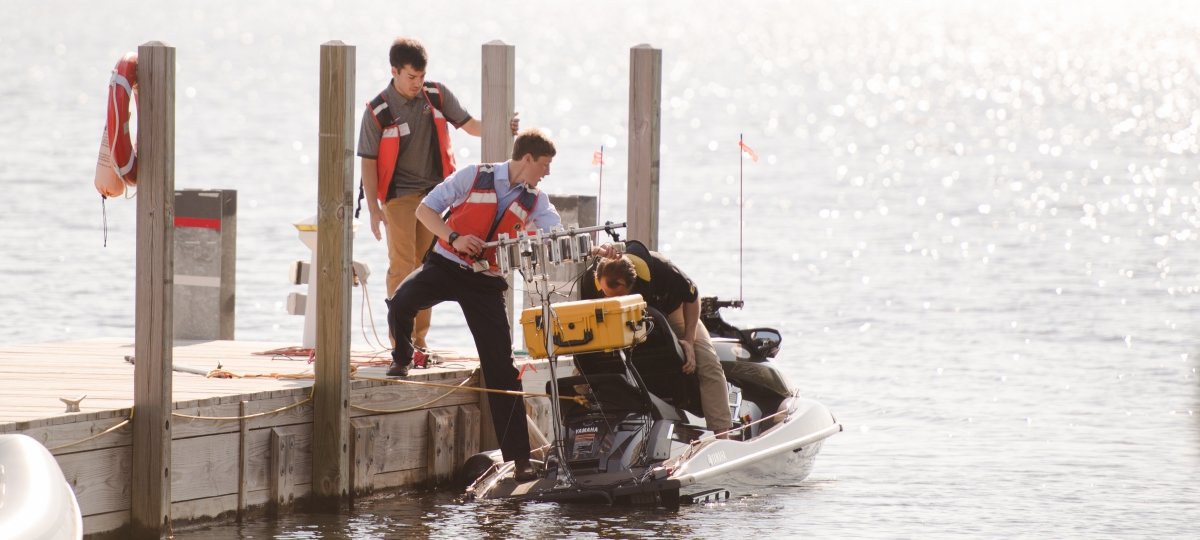
The remote-controlled ASV captures vessel motion data and records a navigator's prescribed maneuvering strategies to maximize vessel stability in rough seas. This jet ski also enables researchers to explore advanced environmental sensors to develop next-generation autonomous control systems, capable of making navigation decisions like an experienced driver. Take a closer look at the sweet ride.
Yamaha WaveRunner FX SVHO Cruiser
1.8L supercharged, 4-cylinder, 4-stroke, super vortex high output marine engine
1,812 cc
1.5 seconds*
140"
50"
August 10, 2018
820
70 MPH
Custom Upgrades
- Servo actuated dual steering cable** (under rear seat)
- Custom Chart Plotter mount with side-scanning sonar and GPS mapping capabilities
- Aluminum electronics mount supports a pelican waterproof case that contains the computer/navigation system
Two Instrument Masts
Bow and stern: the latter includes cameras and a navigation light, and both masts have GPS receivers.
Friction Breakaway System
Prevents large forces from separating the stern mast from the WaveRunner in a rollover event and causing damage to the vehicle.
* When remotely operated, the ASV is kept below planing speed (roughly 10 knots) for safety, but the extra power helps the jet ski respond quickly and have sufficient power to make precise maneuvers in rough seas.
** Added adjustment points allow for quick changes of steering cable trajectory and actuation distance; secondary steering cable allows a human operator to manually steer the jet ski.

Marine Autonomous Test Site Launched
The Smart Ships Coalition and Marine Autonomous Testing Site were launched August 10, at Michigan Technological University's Great Lakes Research Center.
Master Minds Build the Future
Online Program—Master of Science in Civil Engineering
Master Minds spotlights one of Michigan Tech's 43 master's degree programs.
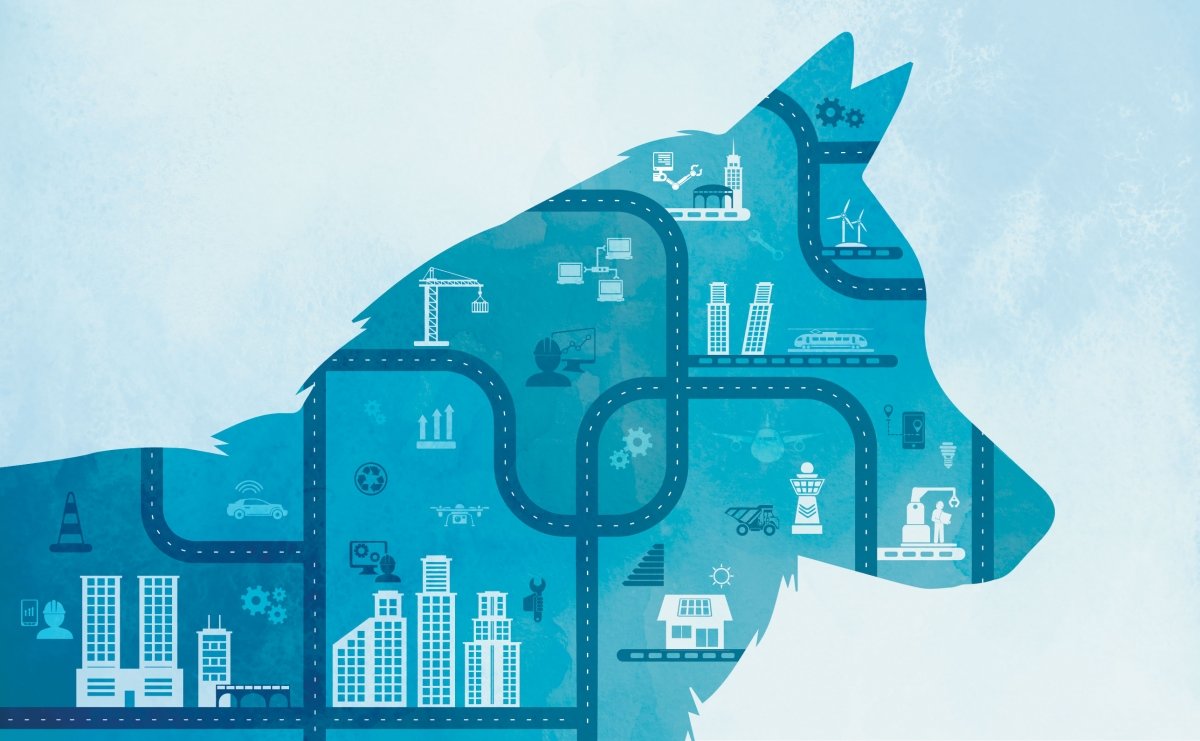
Aging infrastructure—from Michigan to Madagascar—needs engineers to design, build, analyze, and execute civil and structural engineering projects. Our 100 percent online Master of Science in Civil Engineering (MS CE) consists of 10 courses taught by licensed professional engineers with field and industry experience.
Designed for working engineers, Tech's program covers topics like seismic design and new energy compliance. Key areas include examining structural dynamics and materials while digging deep into building codes to create safe and sustainable infrastructure.
An online civil engineering degree from Michigan Tech prepares engineers in as few as five semesters. College Census named Michigan Tech one of 50 online colleges with the best return on investment in 2019. The MS CE program is coursework-focused; it's intended to advance students' present and future careers.
Our program builds on students' existing professional knowledge, says Audra Morse, professor and chair of civil and environmental engineering. She adds that the program "allows professional working engineers to enhance their knowledge and skills, without having to take a break from their working life."
Just like other Michigan Tech academic programs, this degree program combines academic excellence with professional development: Our programs are nationally recognized for academic rigor, graduate employability, and value—US News & World Report ranked eight Michigan Tech graduate programs in the top 100 in the nation—including civil engineering.
Current students and alumni can also get help from Michigan Tech's Career Services, which helps hundreds of Huskies land jobs, co-ops, and internships every year.
The Graduate: First PhD in Integrative Physiology
Matt Kilgas '13 '18 is the first graduate of the integrative physiology PhD program in the Department of Kinesiology and Integrative Physiology (KIP). The graduate program launched in fall 2017 under the leadership of Jason Carter, founding chair of KIP and now associate vice president for research development, and Steven Elmer, assistant professor and graduate program director for KIP—and Kilgas' advisor.
"Matt's graduation marks a major milestone for the KIP department," Carter says. "When we established the department 13 years ago, we envisioned a highly research-active department that would ultimately be capped off with a strong doctorate degree. Our faculty, staff, and supportive administration deserve the credit for their persistence and steadfast commitment to that goal."
Kilgas' graduate research focused on how partial restriction of blood flow to exercising muscles can improve health and enhance performance. He began a tenure-track faculty position in the School of Health and Human Performance at Northern Michigan University in fall 2018.
Meet Husky-Built Oculus-ASR
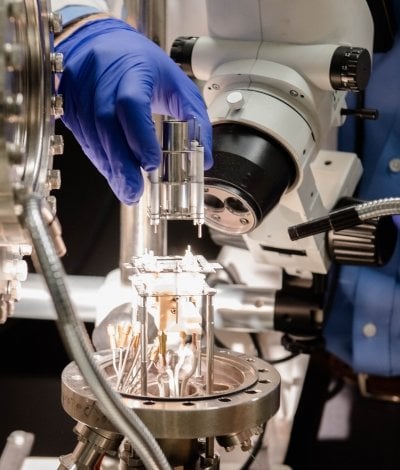
- First nanosatellite deployed from the SpaceX Falcon Heavy
- Weighs 150 pounds
- Orbits 180–2,000 km above Earth on a nine-month mission to calibrate telescopes
- About the size of a mini-fridge
Powered By Publics
Earlier this year, Michigan Tech partnered with more than 100 public research universities and systems to increase college access, eliminate the achievement gap, and boost postsecondary attainment. The collaborative effort, known as Powered by Publics: Scaling Student Success, is organized by the Association of Public and Land-grant Universities. Participating institutions work within "clusters" of four to 12 institutions to implement innovative and effective practices to advance student success on their campuses. Michigan Tech is in the tech cluster. Provost Jacqueline Huntoon and Dean of Students Bonnie Gorman serve as the University's liaisons.
Powered by Publics represents the largest ever collective endeavor to improve college access, advance equity, and increase college degrees awarded. In addition to committing to those goals, participating institutions have pledged to share aggregate data demonstrating their progress to help spur lasting change across the higher education sector.
"Michigan Tech has wonderful programs, faculty, staff, and facilities—we have a lot to offer our students," Huntoon says. "Students who have the opportunity to study at Michigan Tech are well-positioned to enter the workforce and enjoy a fulfilling and high-paying career. I am excited to share our best practices and learn from other institutions about their efforts so that we can attract and serve a broader segment of the population than ever before."
Deep Dive
Great Lakes Research Center's advanced technology pinpoints historic shipwrecks.
Nearly every time researchers at Michigan Tech's Great Lakes Research Center (GLRC) deploy side-scan sonar on the Keweenaw Waterway, something previously undiscovered is revealed. In spring 2018, researchers were taking out-of-town visitors on a waterway tour aboard the Research Vessel Agassiz when the EdgeTech Tow Fish sonar pulled in a larger-than-usual real-time image on the pilothouse display screen. Further investigation revealed one of the most pristine shipwrecks ever discovered between Keweenaw and Thunder Bay, Ontario (hull paint colors still visible, ship's wheel and bell intact). The latest discovery illuminates new challenges inherent in technological expansion, particularly because marine artifacts that do not lie on Great Lakes bottomlands aren't protected by the state or federal laws that govern submerged cultural resources in the Lakes proper. Determining ownership, and how to best preserve historic artifacts, can be as murky as Michigan's turbid inland waterways. Documentation of the find continues by Michigan State Police.
The trajectory of the mission is clearer but no less mysterious on the Big Lake this summer, as GLRC launches the hunt for two of Lake Superior's most elusive shipwrecks, the World War I era French minesweepers Cerisoles and Inkerman. The 141-foot vessels, built in Thunder Bay, Ontario, as the last in a fleet of 12 built for the French government, met their fate a century ago in a November gale, claiming a combined crew of 79, the largest loss of life in Lake Superior maritime history. Last spotted off the tip of Keweenaw Peninsula, the ships were reported missing on their maiden voyage when the third ship in the flotilla reached Sault Ste. Marie.
In addition to side-scan sonar, underwater robots and crowd funding are a vital part of the deep-water search, which is based out of Copper Harbor, Michigan, and began in spring 2019. The project is funded through $12,500 in donations raised via Michigan Tech's Superior Ideas crowd funding platform.
Caresoft Global Gifts Multimillion Dollar Technology
In January, engineering solutions company Caresoft Global gifted to the University a software and data program that allows students to gain actionable intelligence and insights behind some of the leading path-breaking vehicles in the world today. The ground-breaking automotive benchmarking technology has a commercial value exceeding $3 million, and Michigan Tech is the first in the nation to introduce and include the software and data program in its mechanical engineering curriculum.
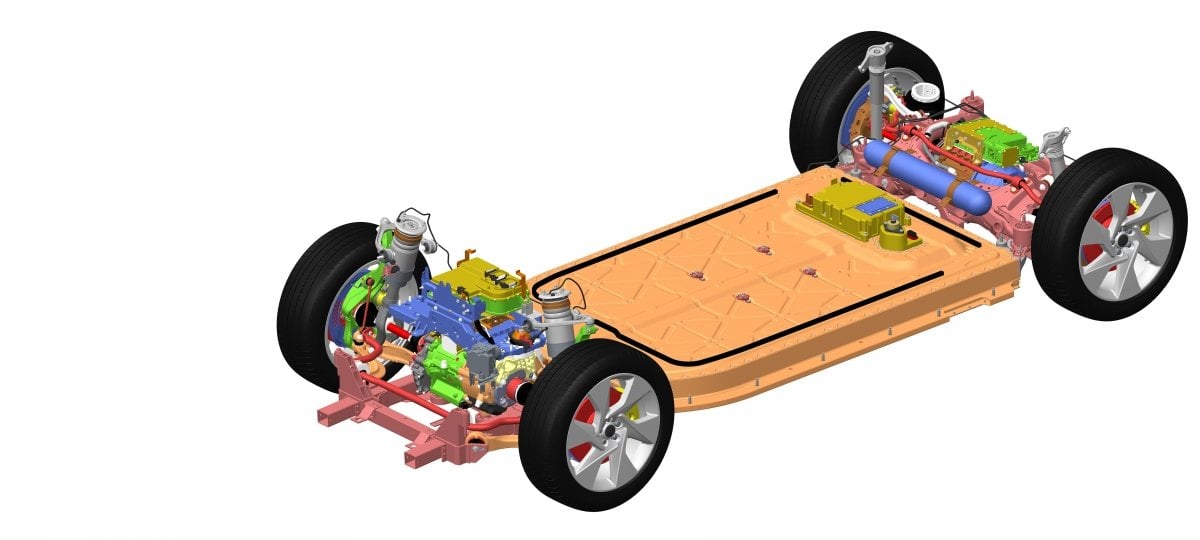
"The fact that Caresoft chose Michigan Tech to be the first university in the country to implement this software demonstrates the world-class reputation and research of both our mechanical engineering department and the institution as a whole," says Janet Callahan, dean of Michigan Tech's College of Engineering. "We are honored by Caresoft's generosity and look forward to building our relationship with the company for many years to come."
Isle Royale Winter Study: New Wolves, Radio-Collared Moose
Michigan Tech's 2019 Isle Royale Winter Study focuses on the implications of newly introduced wolves and the movements of newly collared moose.
Fifteen wolves, 2,060 moose. Extensive ice and deep, powdery snow. In its 61st year, the annual Winter Study report is the longest-running examination of a predator-prey relationship in the world.
The report chronicles a research expedition to the island, where researchers track—by ski and plane—wolves and moose, and catalog the cascading effects of an ecosystem that has lacked a healthy population of apex predators for a number of years.
Prior to the wolf reintroductions, the wolf population on the remote island had remained at just two—a strongly bonded, but also highly inbred, male-female pair—for three years. The moose population, lacking predation, expanded by an average of 19 percent each year during the past eight years since 2011, when the wolf population first dwindled to fewer than 10.
The National Park Service (NPS) introduced four Minnesota-born wolves. In late October, the male wolf died; in January, one of the female wolves left the island by crossing the ice bridge that had formed on Lake Superior, which reached nearly 95 percent ice cover.
During the winter, NPS, in collaboration with the Ontario Ministry of Natural Resources and Forestry, introduced 11 Canadian-born wolves. There are now eight males and seven females on the island.
Researchers fitted the first GPS-enabled radio collars since 1985 to the newly introduced wolves and 20 moose. The collaring efforts are part of a collaboration with University of Minnesota College of Veterinary Medicine, NPS, and Grand Portage Band of Lake Superior Chippewa.
Collaring the moose will also help researchers understand the effects of predation, as well as other factors that influence the moose population, including forage abundance, parasites, and climate.
"This summer should likewise prove valuable in determining the trajectory of both wolf and moose populations. This is definitely a notable year," says Rolf Peterson, research professor.
Indeed, there is a sense of renewal in this year's report. For the first time in 10 years, the researchers spotted fresh wolf tracks at Windigo, located on the southwest end of the park.
Huskies in the Crowd: Emily Byrd
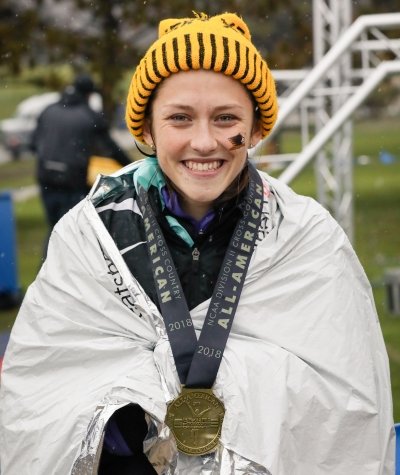
Emily Byrd became the second All-American in Michigan Tech women's cross country program history at the 2018 NCAA Division II National Championships.
H-STEM Complex Planning Moves Forward
In December 2018, the Michigan Legislature granted planning authorization for the H-STEM Engineering and Health Technologies Complex (H-STEM Complex). A $44.7 million capital outlay project, the H-STEM Complex will support Michigan Tech's integrated educational programs that apply engineering and science to improve the human condition.
The H-STEM Complex will comprise newly constructed shared and flexible lab spaces, co-located with renovated classrooms and learning spaces in Michigan Tech's Chemical Sciences and Engineering Building. The project request included a proposed $29.7 million in State support, with $15 million in matching funds. The Michigan Tech Board of Trustees approved expenditures in March 2019 to complete planning and design.
The New College of Computing
It's in our cars and our homes. It affects our bank accounts, our highest levels of governance, our grocery shopping routines. Cybersecurity, data science, and artificial intelligence all feed into software. Tomorrow needs people who can integrate digital tools with the demands of the physical world.
On July 1, 2019, Michigan Tech launched the College of Computing—the first and only college of its kind in the state of Michigan—to meet the technological, economic, and social needs of the 21st century.
Our academic programs are grounded in computing, and many can interface with other disciplines in engineering, business, forestry, health sciences, arts, and social sciences. The core programs include:
- computer science (BS, MS, PhD)
- computer networks and system administration (BS)
- cybersecurity (BS, MS)
- software engineering (BS)
- health informatics (MS)
College of Computing research will have both a core and an interdisciplinary component and will closely align with the Institute of Computing and Cybersystems, Michigan Tech's computing-focused research center with membership spanning 14 different academic units.
The College of Computing has a University-wide service mission and will deliver a computing component in general education, create and staff a Computing Learning Center, and share responsibility for new degrees in computing as well as share oversight of the Michigan Tech High Performance Computing Facility.
Michigan Technological University is an R1 public research university founded in 1885 in Houghton, and is home to nearly 7,500 students from more than 60 countries around the world. Consistently ranked among the best universities in the country for return on investment, Michigan's flagship technological university offers more than 185 undergraduate and graduate degree programs in science and technology, engineering, computing, forestry, business, health professions, humanities, mathematics, social sciences, and the arts. The rural campus is situated just miles from Lake Superior in Michigan's Upper Peninsula, offering year-round opportunities for outdoor adventure.

